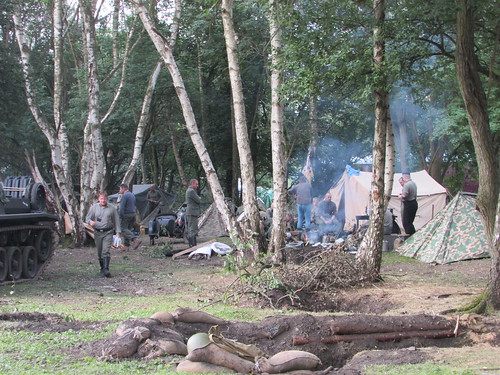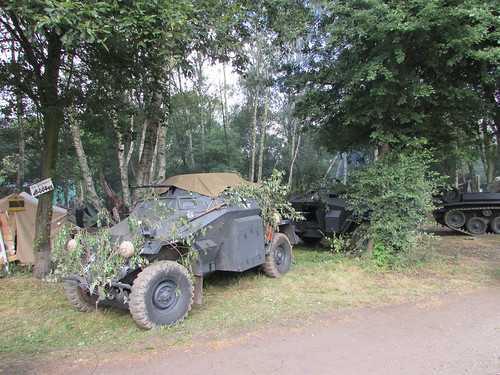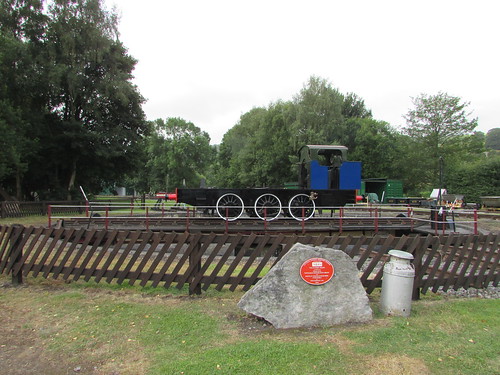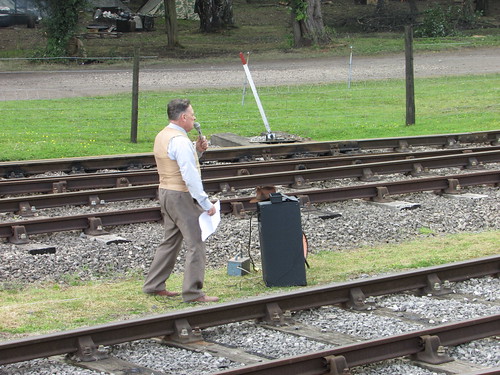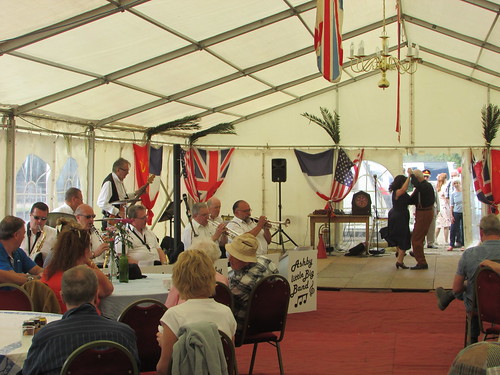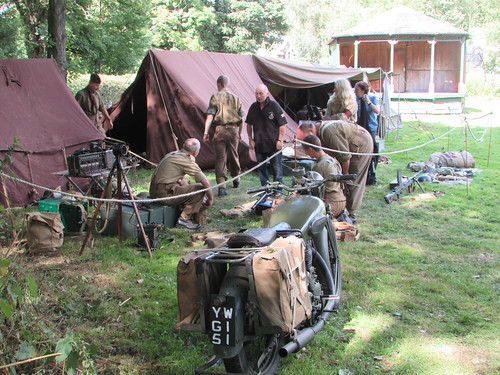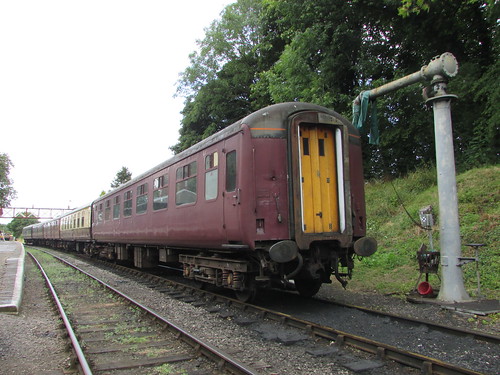Events of Sunday, 6th January 2013
'Sapper', running bunker first to Rowsley, pauses at Darley Dale on 6th January 2013.
Introduction
Since Peak Rail inaugurated its extension to Matlock (Town) described in Matlock Station Festival Reopening, trains have not normally called at Matlock Riverside. In 2013, Peak Rail advertised a Winter Service of four round trips betweeen Rowsley and Matlock Riverside on both Saturdays and Sundays during January and February, so we reverted to the old method of working with one steam locomotive in service running round its train at Matlock Riverside and Rowsley.
I was reminded that 'Sapper' first visited Peak Rail to help with the 'Santa' trains for Christmas 2011 and stayed for a while. I wrote about another day on 'Sapper' on 15th January 2012 in the post Peak Rail in Winter.
'Sapper' returned to help with the 'Santa' trains for Christmas 2012 (sporting new ladders to reach the top of the saddle tank and a modified 'paint job'). Again, this popular visitor stayed to work the Winter Service in 2013. Fortunately, January 2013 was proving much milder than in the previous year. I was 'marked' as Driver on Sunday 6th January when it was overcast, misty and rather cold but without the freezing conditions of the previous year. I was rostered with Richard as Fireman during the morning and Phil taking over in the afternoon. Mike was there all day as our Cleaner.
Locomotive Preparation
No Driving Experience Course was booked, so I was able to sign-on as late as 08:45. Richard and Mike had arrived earlier and 'Sapper', standing on the outside pit at Rowsley, was already in steam. I've written a separate post describing the driver's duties in preparing 'Sapper' for traffic - Preparation of Locomotive 'Sapper'.
Into Traffic
We were ready, with a full tank of water and both injectors tested, by 10:15. Rob had given me the Train Staff for the Church Lane - Rowsley section, which we would need to come through the crossover at the south end of the loop to reach our 5-coach train, so we gently moved off and shunted across to the stock. Our Guard hand signalled us onto the stock, and we gently compressed the buffers before making the locomotive safe for the Cleaner to go between and couple up - regulator closed, handbrake on, reverser mid-gear, cylinder drain cocks open. With screw coupling, steam heating hoses and vacuum hoses connected, we were able to start carriage warming and create vacuum in the brake system to allow the Guard to carry out his tests. There is an earlier post which talks about attaching a locomotive to its train at Peak Rail called On the Footplate (Part 2). The Guard gave me the load - five coaches for a little over two hundred tons nett. We 'synchronised watches'. I always accept the Guard's time. Then we had enough time before the first departure for a snack and a cup of tea.
11:15 to Matlock Riverside
A couple of minutes before departure, the Station Master asked if we were ready and, having confirmed that we were, I set the engine for departure. I fully applied the steam brake so that the Fireman could easily unscrew our handbrake then I left the steam brake partially applied so that the train was under control and could not move even when the Guard wound his handbrake 'off'. Finally, I put the reverser into 'Full Forward' gear, keeping the cylinder drain cocks in the open position.
At 11:15 we received the 'Rightaway' from the Guard, I had a final look ahead, received the Fireman's confirmation that we were "Clear for Ahead" his side, gave one whistle in acknowledgement to the Guard and as a warning to anyone around the permanent way that we couldn't see, fully released the steam brake and judiciously pushed the regulator open. The 'feel' of regulators varies a lot from engine to engine. I wanted enough steam to start moving the train but not so much that the train was jerked into motion or, worse, the engine "picked up her feet" and slipped. An engine should always be started in Full Gear so as to have maximum torque available. On a 2-cylinder engine like 'Sapper', either cylinder could be on 'dead centre' at the instant of starting, meaning that the train needs to be started with the effort of just one cylinder. However, as soon as there's movement, the energy of motion will ensure that passing through 'dead centre' on either cylinder will not cause a problem and maximum torque will no longer be required except on exceptional adverse gradients or with exceptionally heavy loads. After a few 'chuffs' from the exhaust, I 'notched-up' the gear, reducing the demand for steam and allowing expansive working (where more useful work is extracted from the steam by expanding it to a lower temperature before exhausting it to the chimney). Happy that the steam being expelled from the drain cocks had 'purged' the cylinders of condensate, I shut the cylinder drain cocks.
I like to take the train out of the platform reasonably slowly for various reasons. You occasionally get passengers trying to board or alight while the train is moving. The station staff may spot a slam-door improperly closed with a handle 'cocked' (in the old days, one member of staff would normally be positioned near the front of the train as a 'last resort' method of closing such a door without the embarrassment all round of the guard having to 'destroy the vacuum' to bring the train to a stand). In addition, the boiler is suddenly being presented with a demand for steam and the cylinders and motion are being put under load. I like to listen and look to satisfy myself that all is well.
Once the rear of the train is clear of the platform I pushed the regulator a bit further open and allowed the speed to build. Once the train is clear of the run-round loop at Rowsley, the line speed limit of 25 m.p.h. applied until the level crossing at Church Lane. Only 5 minutes is allowed in the timetable from Rowsley to Darley Dale so, with the gentle start I prefer, it doesn't leave too long for the remainder of the run.
Both driver and fireman are normally on the look-out for Church Lane's Up Home signal - a delightful Midland Railway wooden post signal with a lower quadrant stop arm at the top and a fixed distant for Darley Dale below. Sighting this signal is not ideal at the best of times but the day was fairly cold so the front of the locomotive was wreathed in steam condensed to a white fog even after I'd closed the regulator and dropped the reverser into full forward gear (to minimise wear in the pin joints). Drifting towards Church Lane Up Home signal gave me the first opportunity to see how well the train was rolling and judge the braking effort which would be needed to stop at the signal, if necessary. Before we'd sighted the signal, I had to use the driver's brake valve to drop the train pipe vacuum to 15 inches of mercury to make an initial braking application. Once I was happy with our speed, I 'blew the brakes off' again, optimistically hoping that the signal would clear before we needed to brake further to stop at the signal. The signal arm came off, so I acknowledged with a short 'toot' on the whistle and opened the regulator for a few 'chuffs' to prevent speed from dropping further. I retrieved the train staff for the Rowsley - Church Lane section from the back wall of the cab. The staff travels in a 'pouch' attached to a covered hoop allowing the signalman to 'catch' it by placing his arm through the hoop as we hold it out. Both engine crew and signalman have to lean well out towards one another for the 'catch' to be successful and it's important to observe the speed restriction.
The 'clear' signal we'd just passed confirmed that the motor points ahead were correctly set for the 'Up' platform and that the line was clear up to the level crossing gates at Darley Dale so, as soon as the staff was safely exchanged, I linked up the gear a couple of notches and put on steam in the hope of achieving a 'Right Time Arrival' in Darley Dale. Darley Dale North Ground Frame which used to give access to two storage sidings on the Up side has been abolished and the frame itself together with the points and trackwork have been taken away. At about the location of the frame, I shut the regulator once again and 'dropped' the reverser into full gear.
Approaching Darley Dale I had to judge the braking needed to enter the platform at a comfortable speed, run along the platform and quietly stop just short of Darley Dale's Up Home bracket signal. Before the train came to a complete stand, I released the vacuum brake to reduce the chance of a jerk as we stopped. The drivers' mantra for this is "Stop on a rising vacuum."
There's a slight complication on 'Sapper' in that the application of the vacuum brake on the train does not affect the locomotive steam brake - the two brakes are not 'coupled' so, as the train came to a stand, I made a simultaneous steam brake application to stop the locomotive at the same time. Correctly done, this prevents the locomotive from trying to run on, being restrained by the coupling and bouncing back onto the train with a 'thump'. If the steam brake is braking harder than the vacuum brakes on the train, there's the opposite problem of fore-and-back motion as the train 'catches up' with the engine and then bounces off.
Braking has to be judged according to the actual rolling resistance of the train on the day. All sorts of factors affect the rolling resistance of a train but it always seems to reduce somewhat during the day. I suspect this may be related to the axlebox frictional losses reducing as the oil warms a little but I don't know. Locomotives themselves seem to perform better after a hour or so but whether that's for a similar reason as the oil 'gets round', or related to the temperature gradient through the boiler from firebox to smokebox stabilising or related to condensation losses in the cylinders minimising, again, I don't know. But, for years, I've known the old saying "It's a different engine in the afternoon!".
With only a short pause at Darley Dale, I'd partially applied the steam brake to control the train and opened the cylinder drain cocks (always called 'taps' by enginemen, for an obvious reason).
When station duties were finished, the Guard gave a handsignal to the Signalman that we were ready to depart, the signalman opened the gates to the railway and pulled off the Up Home signal - an LMS wooden post with bracket cantilevered to the right carrying an upper quadrant stop signal. Once we had the green flag from the Guard, it was check ahead from both sides of the footplate, whistle, release the steam brake and ease the regulator open. Once we were moving, I 'linked up' the gear, shut the 'taps' and squatted down in the cab doorway so that I could collect the single line staff for the Darley Dale - Matlock single line section which the signalman, standing on the road crossing, was holding up for me to collect. This staff has a covered hoop (like the one I'd surrendered at Church Lane) but, instead of a pouch, the staff is attached to the hoop by a short chain.
Single Line Procedures
Once I'd collected the staff, I made sure it was the right one. The Church Lane - Rowsley staff is rectangular with the place names engraved on it whereas the one I'd just collected was round engraved 'DARLEY DALE - MATLOCK'. Before I hung it on the back wall of the cab, I held it out for the Fireman to check shouting "Correct Staff!" Single Line Working with a Staff is safe, as long as people follow the procedures. Failure to do so can have tragic results such as the Abermule Disaster in 1921 (see the Wikipedia article and the newsreel film of the aftermath here.
Adjusting the Regulator
I'd set the regulator so that the whole train would pass over the road crossing and the points at the south end of the loop at a sensible speed then I eased the regulator a little further open to start to accelerate. I glanced at the boiler pressure gauge to make sure that the increased steam consumption was not causing distress and, satisfied, pushed the regulator to give full 'pilot' (also called 'first') valve. This was nowhere near the locomotive's capacity using 'main' (also called 'second' valve) but quite sufficient for our reasonably "featherweight" train. There's a bit more explanation of regulators in the post Locomotive Regulators.
Foot Crossing
With speed picking up, I sounded the whistle for our approach to the foot crossing at Red House Cutting. Both driver and fireman should be looking out for trouble at this point. The whistle, of course, is to alert people near the crossing to our approach. The sensible thing is for pedestrians to stand clear and wait for us to pass, then cross in safety. But I'm afraid you do get unwise people from time to time who decide to run across, rather than wait. They never seem to consider that, if they stumble, they're putting themselves at risk. A train is not like a car and, even at our moderate speeds, if a driver makes an Emergency Brake Application, the train will take some distance to come to a stand. In a car, the driver can rely on passengers being seated and strapped in but, on trains, passengers can be standing, walking or carrying hot drinks. It's possible to injure a number of passengers in the train with an Emergency Stop and a driver should be aware of that.
Red House Cutting foot crossing, looking towards Matlock (the picture was actually taken from the brake van of a freight train heading north).
On to Matlock Riverside
There was a temporary speed restriction extending from the foot crossing down to Bridge 35 (the Derwent River Bridge) so, having got the train rolling, I had to partially close the regulator to prevent the speed from rising on the falling gradient - it's about 1 in 400 until Bridge 35, then it's uphill (see gradient diagram below).

There's another whistle board approaching the accommodation crossing a little further on and, near there, I shut off steam altogether, place the reverser in 'Full Gear' and let the train drift. There's another whistle board and accommodation crossing a little further on. Apart from the intermittent farm vehicles going to tend the stock in the fields on our right, we get quite a few fishermen who take their cars into these fields to park, then walk to the Bank of the Derwent to fish.
Photographs
Peak Rail Winter Service 2013.
'Sapper' Austerity Tank Locomotive.




